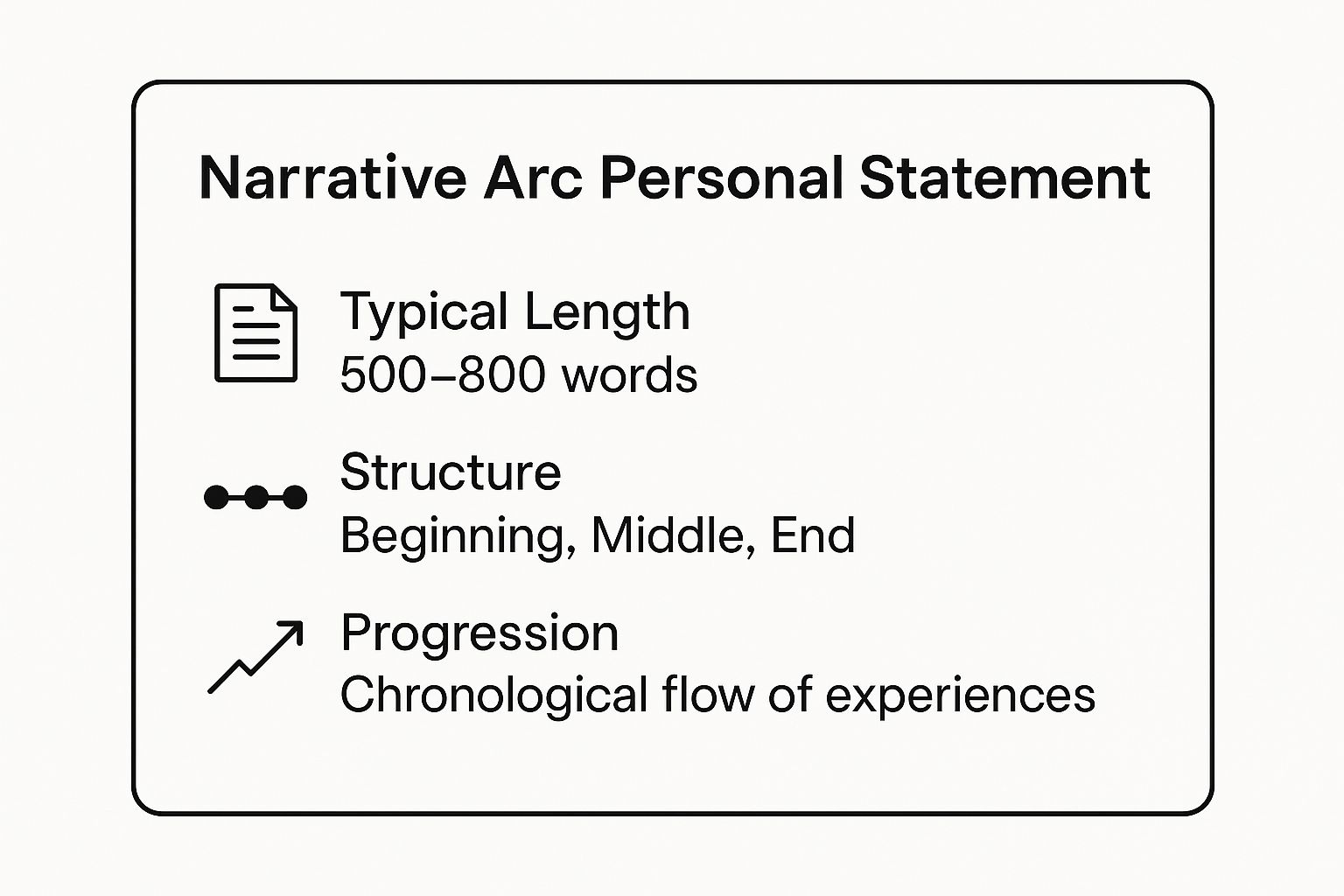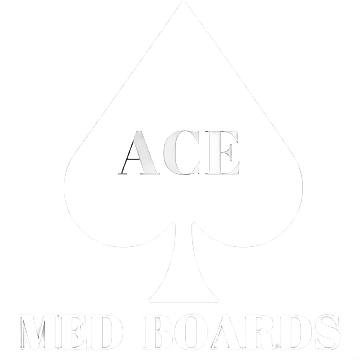The personal statement is your single most important opportunity to answer the admissions committee's fundamental question: "Why do you want to be a doctor?" More than a list of accomplishments, it is a narrative that must weave together your experiences, motivations, and suitability for a career in medicine. It’s the human element of your application, the story behind the grades and MCAT scores. Getting it right is non-negotiable. A compelling essay can distinguish you in a sea of qualified applicants, while a generic or poorly executed one can undermine an otherwise strong profile.
This guide moves beyond vague advice. We will dissect several types of successful essays, providing a sample personal statement medical school applicants can learn from. You won't just read strong examples; you will understand why they are effective. For each statement, we provide a strategic breakdown, analyzing its structure, narrative choices, and the specific ways it demonstrates the core competencies medical schools seek, such as empathy, resilience, and intellectual curiosity. As you begin your journey to craft a compelling medical school personal statement, it's beneficial to grasp core principles on how to write better essays to build a strong foundation.
Our goal is to give you a replicable framework. You will learn to identify your unique story and translate it into a powerful narrative. This article breaks down six distinct and effective personal statement archetypes:
- The Narrative Arc Personal Statement
- The Challenge-Overcome Personal Statement
- The Service-Oriented Personal Statement
- The Research-Focused Personal Statement
- The Non-Traditional Path Personal Statement
- The Cultural Identity Personal Statement
1. The Narrative Arc Personal Statement
The Narrative Arc is a classic storytelling approach and a highly effective strategy for a sample personal statement medical school search. This style frames your journey to medicine as a compelling story with a clear beginning, a developing middle, and a forward-looking end. It chronologically connects your initial inspiration, formative experiences, and challenges overcome to demonstrate maturity, self-reflection, and a sustained commitment to medicine.
This method is powerful because it allows admissions committees to see your growth over time. Instead of just listing accomplishments, you are weaving them into a cohesive narrative that reveals the "why" behind your ambition. A strong narrative shows how each experience, whether a research project, a volunteer shift, or even an academic setback, shaped your understanding of medicine and solidified your desire to become a physician.
Why This Approach Works
The Narrative Arc excels at demonstrating personal development. It’s an ideal format for applicants who have a clear, linear progression of experiences that led them to medicine.
- Shows, Doesn't Tell: By describing specific scenes and interactions, you demonstrate qualities like empathy, resilience, and curiosity rather than simply stating you have them.
- Creates an Emotional Connection: A well-told story resonates with readers, making your application more memorable and impactful.
- Highlights Growth: It effectively illustrates how you've matured, learned from challenges, and developed the core competencies of a future physician.
Strategic Breakdown & Actionable Tips
To craft a successful narrative statement, begin with an engaging hook, a specific moment that sparked your interest or significantly altered your path. This is far more effective than a generic opening like "I have always wanted to be a doctor."
From there, guide the reader through pivotal experiences. For each one, reflect on what you learned and how it contributed to your goal. For instance, a pre-engineering student might describe how volunteering at a children's hospital revealed a passion for direct patient interaction that their technical studies lacked. A non-traditional applicant might narrate how a personal health crisis exposed them to the compassionate side of medicine, inspiring a career change.
The following infographic highlights the core structural components of the Narrative Arc personal statement.

This visual summary underscores the importance of a structured, chronological flow to build a convincing and easy-to-follow story for the admissions committee. The concluding paragraph should synthesize your journey and present a clear, compelling vision for your future career in medicine, connecting your past experiences to your future aspirations. For more insights on building a strong application, you can find expert guidance on medical school admissions prep.
Ultimately, the Narrative Arc personal statement transforms your application from a list of achievements into a memorable story of purpose and dedication.
2. The Challenge-Overcome Personal Statement
The Challenge-Overcome approach centers your personal statement on a significant obstacle you have faced, using it to demonstrate resilience, maturity, and problem-solving abilities. This type of sample personal statement medical school is effective because it frames adversity not as a point of weakness, but as a crucible that forged key qualities essential for a physician. The focus is less on the hardship itself and more on your response to it and the growth that resulted.
This method allows you to transform a potential vulnerability, like a learning disability, a family crisis, or a personal illness, into a powerful testament to your character. It provides concrete evidence of your ability to persevere, adapt, and learn from difficult circumstances. Admissions committees are not just looking for academically perfect students; they are seeking future physicians who can handle the immense pressures and unexpected challenges of a medical career.

Why This Approach Works
The Challenge-Overcome framework excels at showcasing core competencies like resilience and adaptability, which are difficult to quantify elsewhere in an application. It is ideal for applicants whose path to medicine was shaped by a significant life event.
- Demonstrates Resilience: It provides direct proof of your ability to handle stress and bounce back from setbacks, a critical skill for any physician.
- Reveals Deep Motivation: Often, overcoming a personal or family health issue provides a profound and authentic reason for pursuing medicine, making your motivation highly compelling.
- Highlights Problem-Solving Skills: Detailing the specific steps you took to manage the challenge showcases your analytical and proactive nature.
Strategic Breakdown & Actionable Tips
To execute this strategy effectively, the key is to maintain a professional and forward-looking tone. Begin by briefly and factually introducing the challenge without dwelling on melodrama or seeking pity. The bulk of the essay should focus on your actions, reflections, and the resulting personal growth.
For instance, a first-generation student might describe navigating cultural and linguistic barriers in their family’s healthcare, explaining how this experience taught them the importance of culturally competent care and patient advocacy. An applicant who managed a serious illness could discuss how their journey as a patient gave them a unique perspective on empathy and the doctor-patient relationship. The crucial element is always connecting the lessons learned directly to your future role as a physician.
It is vital to show that you have successfully moved past the challenge and are now stable and prepared for the rigors of medical school. Emphasize your current success and how the experience has made you a stronger, more empathetic candidate. Conclude by synthesizing how overcoming this adversity has uniquely equipped you with the insight and strength needed to excel in medicine. For those preparing for the entire application journey, comprehensive guidance from medical school admissions consulting can be invaluable.
Ultimately, the Challenge-Overcome statement turns a difficult chapter of your life into a compelling argument for your admission, proving you have the grit and character to succeed.
3. The Service-Oriented Personal Statement
The Service-Oriented Personal Statement frames your motivation for medicine through a deep and sustained commitment to serving others. This approach is perfect for applicants whose journey has been defined by extensive volunteer work, community engagement, or advocacy for underserved populations. It showcases altruism, empathy, and a profound understanding of the social determinants of health.

Unlike other styles that might focus on a singular event or a scientific discovery, this statement demonstrates a consistent pattern of behavior that aligns with the core values of the medical profession. It answers the "why medicine" question by showing, through action, your desire to alleviate suffering and address health inequities. A strong sample personal statement medical school search will often reveal powerful essays rooted in service, as they provide concrete evidence of an applicant's character and dedication.
Why This Approach Works
This style is particularly effective for medical schools with strong primary care, community health, or service-learning missions. It directly demonstrates the qualities these programs seek in future physicians.
- Demonstrates Core Values: It provides tangible proof of compassion, leadership, and social responsibility, which are key AAMC Core Competencies.
- Shows Real-World Insight: Service experiences offer a unique perspective on the challenges patients face outside the clinical setting, showing a mature understanding of healthcare.
- Highlights Impact: It allows you to showcase specific, measurable contributions you've made to a community, making your application more compelling.
Strategic Breakdown & Actionable Tips
Begin your statement by immersing the reader in a specific service experience. Instead of stating "I volunteered at a free clinic," describe a particular patient encounter or a systemic issue you observed that solidified your desire to pursue medicine. This creates an immediate connection and establishes the central theme of service.
As you build your essay, connect your various service activities. For example, you might describe how founding a health education program on campus was a direct response to the misinformation you encountered while volunteering at a community health fair. The key is to reflect deeply on these experiences. Don't just list what you did; explain what you learned about systemic barriers, cultural humility, and the role of a physician as a community advocate. You'll need to articulate these insights clearly, much like you would when preparing for a high-stakes interview; in fact, mastering this storytelling can provide a solid foundation as you explore medical school interview tips.
Conclude by synthesizing your service journey and explaining how it has prepared you for the rigors and responsibilities of medical school. Articulate a clear vision for how you will continue to serve as a physician, perhaps by focusing on a specific population like rural communities or a specialty like family medicine or pediatrics. This approach transforms your application from a simple resume into a testament to a life dedicated to service.
4. The Research-Focused Personal Statement
The Research-Focused statement is a specialized approach that highlights an applicant’s deep engagement with scientific inquiry and discovery. This style showcases your journey through the lens of research, framing your motivation for medicine around a central question, a specific project, or a passion for translational science. It’s an excellent way to provide a sample personal statement medical school committees can use to evaluate your analytical skills and intellectual curiosity.
This method goes beyond simply listing your lab experiences. It constructs a narrative that explains the "how" and "why" of your research, connecting the bench to the bedside. You are not just a future clinician; you are a future physician-scientist who understands that medical progress is built on a foundation of rigorous investigation. This statement demonstrates a unique commitment to advancing the field, not just practicing within it.
Why This Approach Works
The Research-Focused statement excels at demonstrating intellectual horsepower and a commitment to evidence-based medicine. It is perfect for applicants with significant, meaningful research experiences who can articulate how this work has shaped their clinical aspirations.
- Highlights Analytical Rigor: It provides concrete evidence of your ability to think critically, solve complex problems, and understand scientific methodology.
- Demonstrates a Unique Angle: It sets you apart from applicants whose experiences are primarily clinical, showing a dedication to improving medicine on a systemic level.
- Connects Science to Empathy: A well-crafted statement can show how your quest for knowledge is driven by a desire to alleviate patient suffering.
Strategic Breakdown & Actionable Tips
To build a compelling research-focused statement, avoid getting lost in technical jargon. The goal is to make your work accessible and explain its significance. Start with the core question that drove your research, describing the "aha!" moment that connected your lab work to a real-world clinical problem.
For each research experience, focus on your specific contribution and what you learned. Did you develop a new protocol, analyze a crucial dataset, or present a poster at a conference? Explain how this process refined your thinking and solidified your desire to pursue medicine. For example, an applicant might describe how their work on a cancer cell line fueled their passion for oncology, not just as a scientific puzzle but as a path to giving patients more time.
The conclusion should synthesize your research journey with your clinical goals. Show the admissions committee that your scientific background has uniquely prepared you for the challenges of medical school and a career as an innovative physician. Your research isn't just a box you checked; it is the very foundation of your medical ambitions. For those looking to excel in the rigorous academic environment of medical school, mastering effective study habits is key. You can find excellent resources to sharpen your academic skills with these medical student study tips.
Ultimately, this personal statement frames you as a candidate who will not only be an excellent clinician but also a contributor to the future of medicine.
5. The Non-Traditional Path Personal Statement
The Non-Traditional Path statement is specifically designed for applicants who did not follow a direct route from undergraduate studies to medical school. This approach is ideal for career changers, older applicants, or anyone with significant life experience outside of a traditional pre-med track. It leverages a unique background, framing it as a distinct asset rather than a deviation from the norm.
This style of sample personal statement medical school focuses on transformation. It explains not just the "what" and "when" of your journey, but the crucial "why" behind your decision to pursue medicine. By articulating the value of your previous career, whether in business, teaching, the military, or another field, you demonstrate a level of maturity, resilience, and real-world perspective that can set you apart. The goal is to show that your non-traditional experiences have uniquely prepared you for the rigors and humanistic demands of a medical career.
Why This Approach Works
The Non-Traditional Path excels at showcasing maturity and a well-considered commitment to medicine. It turns what could be perceived as a disjointed timeline into a compelling story of purpose and conviction.
- Demonstrates Maturity and Insight: Your previous career provides a wealth of experiences that can be connected to the core competencies of medicine, such as communication, problem-solving, and leadership.
- Provides a Unique Perspective: Admissions committees value diverse cohorts. Your background as a teacher, engineer, or veteran brings a different viewpoint to the classroom and clinic.
- Highlights Deliberate Choice: Unlike some traditional applicants, your decision to pursue medicine was likely a significant, calculated change. This demonstrates a deep, tested commitment that is highly convincing.
Strategic Breakdown & Actionable Tips
The key to a successful non-traditional statement is to create a seamless bridge between your past and your future. Begin by establishing your former identity and the catalyst that sparked your transition. For example, a former business executive might describe how managing a corporate wellness program exposed them to the profound impact of preventive health, inspiring a shift from boardroom metrics to patient outcomes.
Clearly articulate how the skills from your previous career are transferable. A teacher can highlight their expertise in explaining complex topics and managing difficult conversations. A military veteran can emphasize their discipline, leadership under pressure, and experience working within a structured team environment. Be explicit about these connections. Address your timeline head-on, explaining how you methodically completed pre-requisites and gained clinical exposure to confirm your new path.
The conclusion should synthesize your journey, presenting your non-traditional background not as a detour, but as a foundational element that will make you a more empathetic, resourceful, and well-rounded physician. A powerful statement will leave the admissions committee convinced that your unique path has provided you with an invaluable perspective. For applicants navigating this specific journey, tailored advice from medical school admissions consulting can be instrumental in framing your story effectively.
Ultimately, the Non-Traditional Path personal statement celebrates your unique journey, demonstrating that your experiences have forged a stronger, more dedicated, and more insightful candidate for medicine.
6. The Cultural Identity Personal Statement
The Cultural Identity personal statement leverages an applicant's unique cultural background, heritage, or identity as the central theme. This powerful approach for a sample personal statement medical school search explains how your personal history has shaped your worldview, your motivation for medicine, and your commitment to serving diverse patient populations. It moves beyond a simple list of activities to offer a deeply personal perspective on healthcare disparities, communication, and patient trust.
This method is particularly effective because it directly addresses the growing emphasis on diversity and cultural competency in medicine. Admissions committees are looking for future physicians who can connect with patients from all walks of life. By grounding your narrative in your cultural identity, you demonstrate a nuanced understanding of the social determinants of health and a readiness to contribute a unique, valuable perspective to the incoming medical school class.
Why This Approach Works
The Cultural Identity statement excels at showcasing self-awareness and a commitment to equity. It's an ideal format for applicants whose cultural experiences have been a primary driver in their pursuit of medicine, especially first-generation students, immigrants, or those from underrepresented backgrounds.
- Demonstrates Cultural Competency: It provides concrete proof of your ability to understand and navigate cultural differences in a healthcare context.
- Offers a Unique Perspective: Your personal story stands out, offering a viewpoint that cannot be replicated by other applicants and enriching the diversity of the student body.
- Highlights Empathy and Resilience: Narratives rooted in cultural identity often involve overcoming barriers, fostering a deep sense of empathy for marginalized communities and demonstrating resilience.
Strategic Breakdown & Actionable Tips
To craft a compelling Cultural Identity statement, begin by identifying a specific experience where your cultural background intersected with healthcare. This could be a personal or family encounter with the healthcare system, a time you acted as a language or cultural translator, or a volunteer experience in an underserved community that reflects your own. Avoid broad generalizations about your culture.
From that initial hook, connect your experiences to your specific medical ambitions. For instance, a first-generation immigrant might describe how witnessing their parents struggle with medical jargon inspired a passion for clear patient communication and health literacy. An applicant from a rural, underrepresented community could discuss how a lack of local, culturally-aware physicians motivated them to return and serve their hometown. The key is to show, not just tell, how your identity has actively prepared you for the challenges of modern medicine.
The conclusion should synthesize these themes, articulating a clear vision for how you will use your unique background to be a more compassionate and effective physician. Frame your identity not just as a part of your past, but as an essential tool you will bring to your future practice. For more strategies on highlighting your unique strengths, consider exploring resources on medical school admissions help.
Ultimately, the Cultural Identity personal statement transforms your application by showing how your life story has uniquely prepared you for a career dedicated to inclusive and patient-centered care.
Comparison of 6 Medical School Personal Statement Types
| Personal Statement Type | Implementation Complexity 🔄 | Resource Requirements ⚡ | Expected Outcomes 📊 | Ideal Use Cases 💡 | Key Advantages ⭐ |
|---|---|---|---|---|---|
| Narrative Arc Personal Statement | Moderate – requires strong writing skills, clear structure | Moderate – time for reflection and drafting | Engaging, clear storytelling showing growth & commitment | Applicants with clear progression of medical experiences | Easy to follow, emotional connection, shows growth |
| Challenge-Overcome Personal Statement | Moderate-High – needs balance of vulnerability and professionalism | Moderate – requires thoughtful reflection | Highlights resilience, problem-solving, and personal strength | Applicants with significant adversity shaping character | Reveals determination, empathy, and maturity |
| Service-Oriented Personal Statement | Low-Moderate – straightforward to write with clear examples | Moderate – requires documented service involvement | Demonstrates altruism, leadership, and commitment to service | Those with strong volunteer/community involvement | Aligns with medical mission, shows leadership, genuine intent |
| Research-Focused Personal Statement | Moderate-High – demands explanation of technical content | High – requires significant research experience | Shows intellectual rigor and scientific contribution | Applicants to research-intensive or MD/PhD programs | Demonstrates scientific thinking, unique expertise |
| Non-Traditional Path Personal Statement | Moderate – careful explanation of transition needed | Low-Moderate – relies on prior career experience | Highlights maturity and transferable skills | Career changers, older applicants, non-traditional paths | Unique perspective, shows commitment and maturity |
| Cultural Identity Personal Statement | Moderate – must avoid stereotypes, balance identity with merit | Moderate – requires introspection and cultural examples | Demonstrates cultural competency, diversity, and perspective | Applicants emphasizing diversity and cultural background | Adds diversity, shows cultural sensitivity and unique perspective |
Synthesizing Your Strategy: From Sample to Submission
We’ve journeyed through a diverse collection of sample personal statement medical school essays, from the classic Narrative Arc to the powerful Non-Traditional Path. Each example serves not as a template to be copied, but as a blueprint revealing the underlying architecture of a memorable and effective statement. Moving from analysis to action is your next critical step. This involves synthesizing the core strategies we've uncovered and building a unique application narrative that is authentically yours.
The goal was never to find the "perfect" statement to mimic. Instead, the purpose of reviewing each sample personal statement medical school example was to deconstruct the "why" behind its success. We saw how a compelling story isn't just about what happened, but how you frame it, reflect on it, and connect it to your future in medicine. Your task now is to become the architect of your own story.
Core Principles for Your Personal Statement
Let's distill the most vital takeaways from our analysis. These are the foundational pillars upon which you will build your draft:
- Authenticity is Non-Negotiable: Every successful statement, whether focused on research, service, or personal challenges, was rooted in genuine experience. Admissions committees can spot a fabricated narrative from a mile away. Your unique journey, with its specific details and heartfelt reflections, is your greatest asset.
- The "Show, Don't Tell" Mandate: We repeatedly saw how powerful it was to demonstrate qualities rather than just listing them. Instead of saying you are "compassionate," tell the story of the patient encounter that taught you the meaning of compassion. This creates a vivid, lasting impression.
- Reflection is the Engine of Growth: A personal statement is not a resume in prose. It’s an essay about your development. The strongest examples connected an experience (the "what") to a moment of insight (the "so what") and then to future aspirations in medicine (the "now what"). This reflective arc demonstrates maturity and self-awareness.
Actionable Next Steps: Building Your Narrative
Feeling inspired is good; taking action is better. Here is a clear, step-by-step plan to transition from studying examples to creating your own compelling personal statement.
- Brainstorm Your Core Stories: Before writing a single sentence, inventory your key experiences. Think about the pivotal moments from your clinical, research, service, and personal life. Which one or two experiences best encapsulate your motivation for medicine? Which stories reveal the qualities you want to highlight?
- Define Your Central Theme: What is the one key message you want an admissions officer to remember about you? Are you the resilient problem-solver, the compassionate advocate, or the relentlessly curious scientist? Your theme will act as a "north star," ensuring every paragraph serves a unified purpose.
- Outline Your Narrative Arc: Structure is not a constraint; it is a tool for clarity. Whether you choose a chronological path or a thematic one, outlining your introduction (the hook), body paragraphs (the evidence and reflection), and conclusion (the forward-looking vision) will prevent rambling and ensure a powerful flow.
Remember, your personal statement is your voice in a silent, paper-based review process. It’s your chance to make a human connection. While a compelling personal statement is crucial for securing an interview, effective preparation for the interview itself is equally vital. To refine your approach, consider exploring proven interview practice methods to ensure you can articulate your story as powerfully in person as you do on paper.
Ultimately, studying a sample personal statement medical school essay is like a musician studying a master's composition. You learn the theory, appreciate the structure, and internalize the techniques. But then, you must pick up your own instrument and create a melody that is entirely your own. Trust in your experiences, be vulnerable in your reflections, and write with conviction. You have a unique story to tell, and the world of medicine is waiting to hear it.
The journey to medical school is a marathon of high-stakes exams and demanding applications. At Ace Med Boards, we specialize in providing elite tutoring and admissions consulting to help you excel at every stage, from crafting a standout personal statement to conquering your board exams. Let our expert advisors help you translate your unique story into an application that opens doors.

